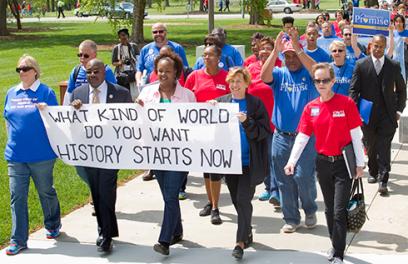A free-market failure in the heartland
It was every supply-side economist’s dream: the promise of achieving economic nirvana by slashing taxes for the wealthy and corporations, and shrinking government. Except it became a nightmare for the people of Kansas, and now the Kansas Legislature has taken a big step toward waking up from it.
Kansas Gov. Sam Brownback turned his state into a laboratory for the most extreme form of trickle-down economics, promising that it would usher in an economic boom. It didn’t. It never has. Brownback’s five-year experiment caused state revenue to plummet, the deficit to explode, and painful spending cuts to be made—including cuts decimating public schools. Last week, a once-unlikely alliance stopped Brownback’s attempt to double down on his plan: Democratic and Republican lawmakers, urged on by parents, business people, civic activists and unions of working people.
You would think that this revolt by Kansas’ citizens and legislators of both parties would send chills up supply-siders’ spines nationwide. But the essential tenets of Brownback’s plan remain at the center of the tax proposals championed by President Donald Trump and House Speaker Paul Ryan. Granted, these free-market tenets are well-established conservative orthodoxy. But, as the Kansas experiment demonstrates, they offer a false promise and lead not to prosperity but to deep austerity.
The Kansas economic plan was intended to serve as a model for other anti-government forces. Instead, it presents lots of inconvenient facts. State revenues plunged $700 million in the first year alone, resulting in deep cuts to everything from road repair to state psychiatric hospitals. The state budget deficit climbed to nearly $900 million. And, while economic growth nationally has remained steady at just above 2 percent annually, Kansas’ growth has been anemic, at 0.2 percent.
The impact on public education in Kansas has been catastrophic. In just two years, Brownback cut $63 million from public colleges and universities. State funding for public universities is 17 percent less than it was in 2008. Since Brownback took office in 2011, state per-pupil spending has dropped from $4,400 to $3,800. A survey of school districts by the Kansas Center for Economic Growth found that 96 percent of districts say their base state aid per pupil is insufficient. Public schools in Kansas have 19,000 more students than they had in 2009, but 655 fewer teachers. Classrooms are crowded, and many school facilities are in disrepair.
With a governor who refused to listen, parents and educators turned to the courts for relief. The Kansas Supreme Court ruled unanimously this spring that state funding for public education is not only inadequate, it is unconstitutional. The court found that black, Hispanic and poor students were especially harmed by the inadequate funding. Last week, the Legislature passed a more robust funding formula, which Brownback was forced to sign.
Another Midwest state has taken a different approach, one that invested in its future. Minnesota Gov. Mark Dayton raised taxes on upper-income individuals and businesses several years ago. Was the move kryptonite to the state’s economy, as Brownback and his fellow tax-cutters would have you believe? To the contrary. Minnesota has the fastest-growing economy in the Midwest, and the state is projecting a $1.65 billion surplus for the next two years. California and New York have chosen similar paths and are growing at twice the rate of Kansas.
You know the oft-quoted definition of insanity: doing the same thing over and over and expecting different results. Cliché aside, it makes no sense that both Trump’s and Ryan’s tax plans are modeled on the failed Kansas experiment—or does it? Political ideology often trumps evidence, and playing to the political base can pay off. Legions of observers have noted that Trump, his family and many of his associates would benefit from virtually every element of his tax plan.
In the midst of the Brownback economic nightmare, on the 60th anniversary of the Brown v. Board of Education decision, I visited Topeka, Kansas, the home of the plaintiffs in the Brown case, to help fight the draconian cuts to public education. Topeka is hallowed ground in the effort to ensure every child receives an equal and adequate education. Six decades after that landmark decision, the state bleakly illustrated how radical economic policies could join racial discrimination in depriving children of the public education they need and deserve.
Stephen Henderson, the editorial page editor of the Detroit Free Press, recently wrote that Brownback hoped his experiment slashing taxes and spending would serve as a “model for the utter trivialization of government, its services and those who count on them.” Brownback could not have been more wrong. Trivializing government and eliminating services have real-life consequences, and the people of Kansas have said “enough.” That is the true model for our country.

